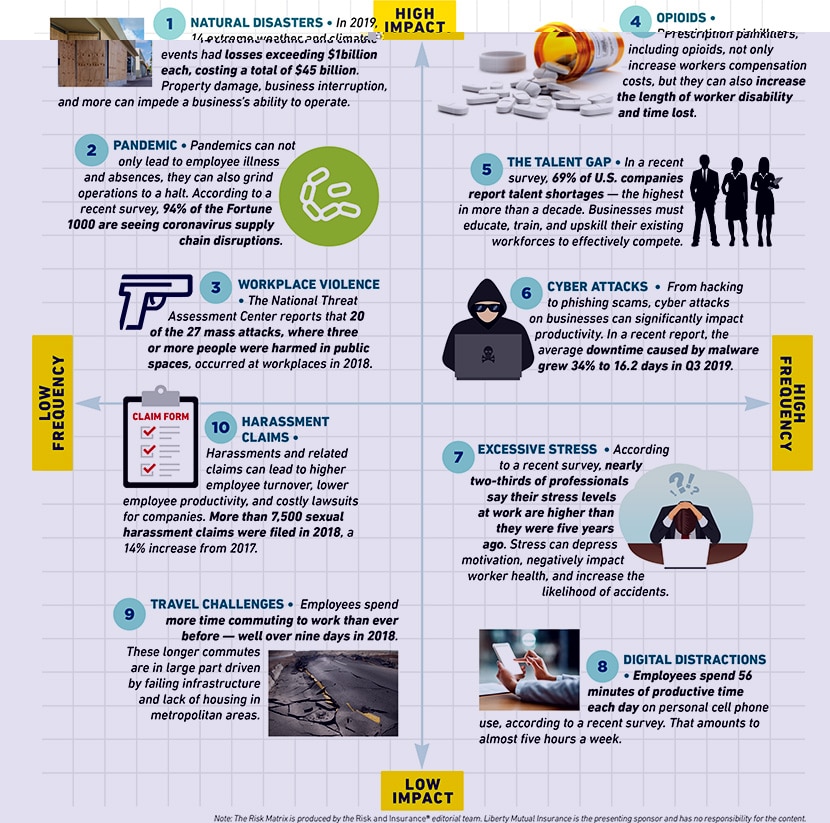
Introduction
For businesses of all types and across industries, a variety of social, technological, and other emerging trends are disrupting day-to-day operations. Pandemics, cyber events, opioids, and other risk factors are negatively affecting productivity and profitability.
The Workplace Disruptions Risk Matrix featuring 10 factors contributing to workplace interruptions every day.
The Risk Matrix, produced by the editorial team at Risk & Insurance®, plots key factors contributing to workplace disruptions based on frequency and severity.
Natural disasters
In 2019, 14 extreme weather and climate events had losses exceeding $1 billion each, costing a total of $45 billion. And continued climate change will lead to even more severe weather in the coming years. To help mitigate the risk of disruptions related to natural disasters, businesses should develop business continuity plans that identify key risks and potential impacts to operations.
Pandemics
Pandemics not only lead to employee illness and absence, but they can also grind operations to a halt. Most notably are recent events stemming from spread of the novel COVID-19 virus that was first detected in Wuhan, China. According to a recent survey, 94% of the Fortune 1000 are seeing coronavirus supply chain disruptions. Social distancing mandates have caused many businesses worldwide to close or downsize in recent weeks. Having a plan on how to respond to a pandemic could help protect employees and communities and reduce the spread.
Workplace violence
Workplace violence can encompass many different levels of threat to the safety of employees and visitors, from a disgruntled worker to the terrifying event of an active shooter. The National Threat Assessment Center reported that 20 of the 27 mass attacks, where three or more people were harmed in public spaces, occurred at workplaces in 2018. Businesses can be held liable for workplace violence incidents through vicarious liability, negligent hiring, or premises liability. Because of the complexity and frequency of workplace violence today, risk managers should fully understand the scope of what fuels these threats, so they can more effectively identify and prioritize actions to safeguard their businesses.
Opioids
Misuse of opioids continues to be a challenge the country, affecting individuals, families, communities, and businesses. According to the Centers for Disease Control and Prevention, nearly 70% of the more than 67,000 deaths attributed to drug overdose in 2018 involved an opioid. In addition, The Council of Economic Advisers (CEA), estimates the economic cost of the opioid epidemic to total $696 billion in 2018 alone. This crisis likely leaves few in our country untouched. Opioids —along with other prescription painkillers— can not only increase workers compensation costs, they can also increase the length of worker disability and time lost. Learn how advocacy and sustained, evolving action can help mitigate the impact of opioids in workers compensation claims.
The talent gap
A recent survey showed 69% of U.S. companies are still reporting talent shortages— the highest in more than a decade. Businesses must educate, train, and upskill their existing workforces to effectively compete. Because of a tightening labor market, along with heightened competition, more companies are outsourcing certain activities to third parties via the sharing economy as well, which might meet current demands but can also usher in additional liability exposures.
Cyber attacks
From hacking to phishing scams, cyber attacks on businesses can significantly impact productivity. In a recent report, the average downtime caused by malware grew 34% to 16.2 days in Q3 2019. Many of these incidents were as a result of hackers who first stole data from businesses, then encrypted the databases for ransom. Training employees on how to spot phishing emails can reduce the risk of these types of cyber threats. With many employees working from home as a result of the COVID-19 pandemic, businesses should use VPN systems to protect remote workers’ computers and cell phones that are used for company businesses.
Excessive stress
According to a recent survey, nearly two-thirds of professionals say their stress levels at work are higher than they were five years ago. Employee health plays a big role in employee productivity. When external factors, such as work or family pressures, weigh on an employee, this added stress can depress motivation, negatively impact health, and increase the likelihood of accidents or missed opportunities.
Digital distractions
A survey found that employees each spend more than eight hours per week— or a full workday — doing other things besides work. Most of this time was spent using personal cell phones —up to 56 minutes of productive time each day. This kind of distraction can cut productivity and increase the likelihood of errors and accidents.
Travel challenges
Employees spend more time commuting to work than ever before — well over nine days in 2018. These longer commutes are in large part driven by failing infrastructure and lack of housing in metropolitan areas, causing employees to live miles away from work. With prolonged commutes, coupled with nearly 270 million vehicles driving daily, employees are vulnerable to accidents and other incidents. For businesses that have employees with driving responsibilities, fatigue is also a concern that can put employee safety and the company at risk. While the COVID-19 outbreak is keeping more and more people at home and off the roads, requests for emergency supply shipments and home deliveries continue to grow. This need puts added pressure on truckers and other delivery drivers that could result in fatigue and accidents.
Harassement claims
Harassment and related claims can lead to higher employee turnover, lower employee productivity, and costly claims for companies. For example, in 2019, the EEOC reports awarding almost $140 million in monetary benefits for harassment-related charges, an 11% increase from 2017. And even though the total number of charges dropped slightly in 2019, increased awareness means new charges and related lawsuits will continue. As larger verdicts begin to escalate, taking steps to create safer and more inclusive workplaces is critical.
Related insights
The Risk Matrix is featured with the permission of Risk & Insurance®. The Risk Matrix is produced by the Risk & Insurance editorial team.
This website is general in nature, and is provided as a courtesy to you. Information is accurate to the best of Liberty Mutual’s knowledge, but companies and individuals should not rely on it to prevent and mitigate all risks as an explanation of coverage or benefits under an insurance policy. Consult your professional advisor regarding your particular facts and circumstance. By citing external authorities or linking to other websites, Liberty Mutual is not endorsing them.




